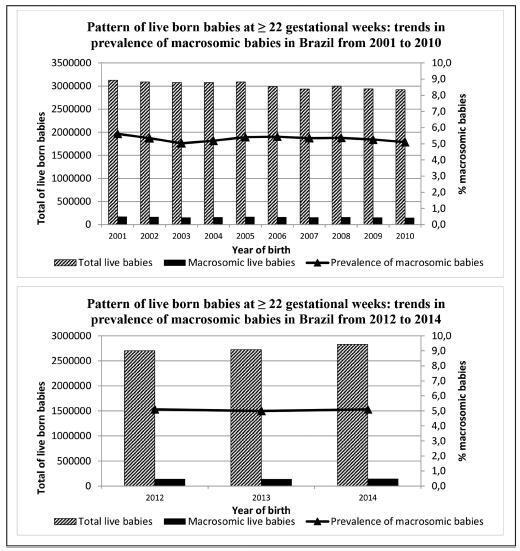Summary
Revista Brasileira de Ginecologia e Obstetrícia. 2003;25(5):375-375
DOI 10.1590/S0100-72032003000500012
Summary
Revista Brasileira de Ginecologia e Obstetrícia. 2017;39(8):376-383
To describe the trends in the prevalence of macrosomia (birth weight ± 4,000 g) according to gestational age in Brazil in the periods of 2001-2010 and 2012-2014.
Ecological study with data from the Brazilian Live Birth Information System (SINASC, in the Portuguese acronym) regarding singleton live newborns born from 22 gestational weeks. The trends in Brazil as a whole and in each of its five regions were analyzed according to preterm (22-36 gestational weeks) and term (37-42 gestational weeks) strata. Annual Percent Changes (APCs) based on the Prais-Winsten method and their respective 95% confidence intervals (CIs) were used to verify statistically significant changes in 2001-2010.
In Brazil, the prevalence of macrosomic births was of 5.3% (2001-2010) and 5.1% (2012-2014). The rates were systematically higher in the North and Northeast Regions both in the preterm and in term strata. In the preterm stratum, the North Region presented the highest variation in the prevalence of macrosomia (+137.5%) when comparing 2001 (0.8%) to 2010 (1.9%). In the term stratum, downward trends were observed in Brazil as a whole and in every region. The trends for 2012-2014 were more heterogeneous, with the prevalence systematically higher than that observed for 2001-2010. The APC in the preterm stratum (2001-2010) showed a statistically significant trend change in the North (APC: 15.4%; 95%CI: 0.6-32.3) and South (APC: 13.5%; 95%CI: 4.8-22.9) regions. In the term stratum, the change occurred only in the North region (APC:-1.5%; 95%CI: -2.5--0.5).
The prevalence of macrosomic births in Brazil was higher than 5.0%. Macrosomia has potentially negative health implications for both children and adults, and deserves close attention in the public health agenda in Brazil, as well as further support for investigation and intervention.

Summary
Revista Brasileira de Ginecologia e Obstetrícia. 2007;29(7):376-378
DOI 10.1590/S0100-72032007000700009
Summary
Revista Brasileira de Ginecologia e Obstetrícia. 2012;34(8):376-380
DOI 10.1590/S0100-72032012000800006
PURPOSES: To describe the process of gait initiation of pregnant women and to compare the behavior of the pressure center in the three trimesters of pregnancy. METHODS: Fifty-seven low-risk pregnant women were evaluated, aged 18 to 35 years, selected for convenience location during the three trimesters of pregnancy. The women were divided into three groups of 19 subjects each, according to gestational age - 1st quarter (4-12 weeks), 2nd quarter (13-28 weeks), and 3rd quarter (29-42 weeks,). Each patient was positioned standing up with one foot on each AMTI force platform until she heard a beep indicating that she should start walking a distance of four meter. Data were analyzed using the SPSS software. The Kolmogorov Smirnov test, Tukey's test and Spearman correlation coefficient were used for group comparisons, with 5% significance level in all tests. RESULTS: Significant differences were found between the 1st quarter (GFT) and 3rd quarter (GTT) groups regarding mediolateral oscillation amplitude (GFT: 0.4 cm and GTT: 0.2 cm) and mediolateral displacement rate (GFT: 0.9 cm/s and GTT: 0.4 cm/s). There was a gradual decrease in anteroposterior and mediolateral oscillation rate, and in the speed of displacement from platform 1 to platform 2 in GFT. There was a significant difference in oscillation amplitude and mediolateral displacement speed between GFT and GTT. CONCLUSION: The variables analyzed showed minor differences and do not constitute an imminent risk for the stability dynamics of pregnant woman.
Summary
Revista Brasileira de Ginecologia e Obstetrícia. 2018;40(7):377-378